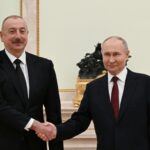Following their modus operandi, the IRGC has been training militant proxy groups, which fought in Syria already, for a new potential task – infiltrating Karabakh and disrupting Azerbaijani control of this area. Karabakh, the UN-recognized Azerbaijani territory, was mostly liberated from Armenian occupation in 2020 (thanks to Israeli military aid to Azerbaijan), except for a separatist enclave, populated by the Armenians.
The presence of Shi’ite militias in this tumultuous region would be a blatant escalation towards armed conflict, potentially leading to total regional war. A scenario which would be familiar to those knowledgeable about the conflict in Syria.
According to the Turkish news outlet Türkiye Gazetesi, the IRGC plans to deploy up to 4,000 militants and IRGC operatives to Karabakh by May 2023. For this reason, the commander of the IRGC special unit Niru-ye Qods Esmail Qaani visited Iraq and Syria in February. The Iranian general instructed the leaders of the Iranian proxy groups to create a unit for special operations.
It is not hard to imagine how the 4,000-man contingent would reach Karabakh when considering the tight-knit relations between Iran and Armenia, as well as the Lachin corridor connecting the latter and the Armenian-populated separatist enclave in Karabakh – Artsakh. Convoys secretly carrying weapons have already been confirmed traveling through lesser-known routes from Armenia to the enclave.
Moreover, the area around the Lachin corridor is under the control of Russian army peacekeepers. Just so it happens that Russia, a major ally of Iran, is supervising the only officially recognized road between Armenia, another ally of the two, and the separatist “autonomous republic” on Azerbaijani soil.
Iran and Russia have solidified their ties over the ongoing Russian war in Ukraine, so it is safe to assume that the IRGC would be able to coordinate with the Russian peacekeepers in Karabakh in order to secure safe and discreet passage into the region, and ensure no interference with their operations against Azerbaijan.
The Iranian-backed proxies which fought in Syria are numerous and diverse. To name a few infamous examples: Liwa Fatemiyoun and Liwa Zainebiyoun. The organizations are made up of Shia extremists trained, organized, and instructed by the IRGC to fight for its interests in turbulent areas on the map.
The Fatemiyoun brigade is mostly Afghans, while the Zainebiyoun brigade is primarily made up of Pakistanis – however, the ethnic makeup of the different Iranian militias varies and includes many other ethnic groups. The binding factor being the IRGC, Khomeinist ideology, and being pronounced enemies of the West and its allies. These groups are willing to carry out the ayatollah’s bidding in the most ruthless of methods.
It is not the only threat: on March 11, an Iranian military plane flew along the border with Azerbaijan without notifying or warning the Azerbaijani side of the maneuver. This incident, in violation of the internationally accepted practice of issuing a warning, was condemned by the Azeri government.
What’s more is that the Iranian aircraft flew close to the Azerbaijani territories in which, according to many IRGC and Iranian official claims, Israel presumably has military assets such as air bases and intelligence gathering outposts.
A day after that Azerbaijani secret services announced the arrests of 32 Iranian agents, who carried out “provocation and disruption acts under the guise of religion.” This is the second large operation since November last year, when a similar number of Iranian operatives and agents were arrested.
Some of them participated in planning and carrying out attempts to kill Israelis in other countries and to collect information about Israeli equipment, which is supplied to Azerbaijani military. Clearly, increased Iranian involvement in Azerbaijani affairs and destabilization efforts leading to potential escalation in the region are not without cause. Tehran sees the tightening of ties between Jerusalem and Baku as a grave threat to its hegemony and seeks out ways to weaken its opponents and provoke a disproportionate response.
Ariel Kogan











